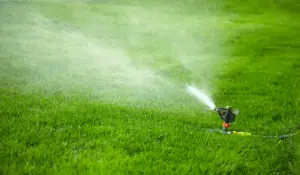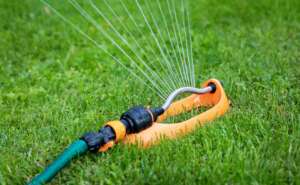Table of Contents
 Achieving a vibrant and thriving lawn requires careful attention to its watering needs. However, determining how often to water can be a perplexing task for many homeowners.
Achieving a vibrant and thriving lawn requires careful attention to its watering needs. However, determining how often to water can be a perplexing task for many homeowners.
Overwatering can waste resources and harm the environment, while underwatering can result in a lackluster and parched lawn. To help you strike the perfect balance, this article presents essential insights and practical solutions for watering your lawn effectively.
By understanding the specific requirements of your grass, considering climate conditions, and assessing soil characteristics, you can establish a watering routine that promotes deep root growth, maximizes water absorption, and keeps your lawn looking lush and healthy.
Additionally, we will explore the optimal time of day for watering to minimize evaporation and potential fungal diseases. With these guidelines, you can confidently maintain a beautiful lawn while conserving water and supporting its long-term vitality.
Factors Influencing Lawn Watering Frequency
Watering frequency on plants depends on the type of grass. Grass needs more water in the summer and less in the winter.
Grass needs more water in sandy soil than it does in clay soil because sandy soil drains quickly. Conversely, clay holds moisture longer than sand, so you’ll want to be careful about overwatering if your lawn is made of this material.
Some grasses are more drought-tolerant than others, so they might be able to go longer without a drink.

The best way to determine how often you should water is by looking at your watering schedule over the past several weeks if you’ve been watering every day or two, scale back slightly—just enough so the lawn can take care of itself for a while. If it hasn’t rained in a while and your lawn looks parched or brown, it’s time for an irrigation session!
Does the Grass Need to be Watered Every Day?
No, grass does not need to be watered every day.
Most lawns require about 1 to 1.5 inches (2.5 to 3.8 cm) of water per week, including rainfall. However, this can vary depending on the specific type of grass. Some grass species, like Bermuda grass, have better drought tolerance and may require less frequent watering, while others, like Kentucky bluegrass, may need more water to thrive.
Rather than watering every day, it is usually recommended to water deeply and infrequently. This means providing enough water to penetrate the soil to a depth of 6 to 8 inches (15 to 20 cm) so that the grass roots grow deeper and become more resilient. Shallow and frequent watering can promote shallow root growth, making the grass more susceptible to drought and other stresses.
To determine when it’s time to water, you can perform a simple “footprint test.” Step on the grass, and if the blades don’t spring back up, it may be a sign that the grass needs watering. Additionally, monitoring the grass’s color can indicate if it needs water. If the grass starts turning bluish-gray or shows signs of stress, it may be time to water.
It’s important to note that overwatering can be detrimental to the health of your lawn. It can lead to shallow root growth, increased disease susceptibility, and water wastage. Therefore, it’s best to water your grass only when necessary and adjust the frequency based on the specific needs of your lawn and the local climate conditions.
What’s The Best Time to Water Your Lawn?
The best time to water your lawn is early morning or late evening when temperatures are cooler, reducing evaporation. This allows the water to penetrate the soil effectively without wasting water through evaporation.
Key Factors Influencing Lawn Watering Requirements
Your lawn needs water depending on several factors, including temperature, evaporation, and rainfall. Let’s take a look at each one individually:
Temperatures
In the summertime (June through August), when temperatures are high, and rain is unlikely to fall for long periods, your lawn will need more frequent watering than in wintertime. You should water about two or three times per week during this season to keep it healthy and green.
When the weather cools down in Sep and Oct (and November in some cases), grass growth slows significantly due to cooler temperatures and fewer daylight hours—which means less water evaporates from your lawn’s surface every day! Because of these two factors, combined with the fact that there’s usually more rain falling during these months anyway (especially in late autumn), watering frequency should also decrease. Once per week should suffice here instead of twice or thrice every seven days like earlier in the summertime!
Rainfall
If you’re unsure how much rainfall your lawn or garden needs, watering it every two weeks is a good rule of thumb.
If it’s been raining regularly and the soil feels moist in the morning, there’s no need to water. The soil should be damp but not saturated with water.
Dry Outside
If it’s been dry outside, you’ll want to check the moisture levels several times throughout the day by digging down your lawn or garden with a trowel or spade (a shovel will also work).
You need to dig about 8 inches deep to get an accurate idea of how much moisture is present in your soil. If you see mud when you dig down into your lawn or garden, then the chances are that it hasn’t rained enough recently, and watering would be beneficial for both plants’ health and homeowners’ green thumbs!
When it comes to watering, what does “deep” mean?
Deep means reaching the roots. Deep watering is more effective than surface watering (where the water runs off). Deep watering helps your grass grow healthier and stronger than surface watering.
Deep watering is better for your lawn because when you apply water only on the surface of the soil, most of it evaporates before reaching the roots. While some moisture reaches deeper into the soil profile (1-2 inches), much of that moisture will quickly evaporate or soak into the ground.
However, deep watering has less evaporation because you’re applying water directly where it’s needed: near plant roots! Also, since most lawns are fairly sandy soil types without much clay content like clay soils tend to hold more moisture longer, there isn’t as much need for frequent irrigation sessions anymore, which means less wasted water and lower bills!
Watering Techniques for Efficient Water Usage

Watering your lawn efficiently is beneficial for the health of your grass and helps conserve water resources. By employing proper watering techniques, you can ensure that your lawn receives adequate moisture while minimizing water waste. Here are some essential watering techniques for efficient water usage:
Deep Watering
Instead of frequent shallow watering, aim for deep watering sessions. This encourages the grassroots to grow deeper into the soil, making them more resilient to drought conditions. Watering deeply also reduces water loss through evaporation.
Water in the Morning or Evening
Water your lawn during the early morning or late evening when temperatures are cooler. This allows the water to penetrate the soil effectively without significant evaporation. Avoid watering during the hottest part of the day when evaporation rates are high.
Avoid Overwatering
Be mindful not to overwater your lawn. Overwatering can lead to shallow root growth, increased disease vulnerability, and wasted water. Use the recommended watering guidelines for your grass type and monitor the signs indicating when your lawn needs watering.
Use Irrigation Techniques Wisely
Select the appropriate irrigation method for your lawn. Sprinklers are commonly used and cover larger areas, while drip irrigation is ideal for targeting specific plantings. Adjust sprinklers to avoid overspray onto hardscapes or sidewalks, reducing water waste.
Consider Rainwater Harvesting
Utilize rainwater by collecting it in barrels or using a rainwater harvesting system. This allows you to use naturally replenished water for rinsing your lawn, reducing dependency on freshwater sources.
Install a Smart Irrigation System
Smart irrigation systems use weather data and soil moisture sensors to adjust watering schedules accordingly. These systems help optimize water usage by watering only when necessary and preventing overwatering during rainy periods.
Mulch and Amend the Soil
Applying a layer of organic mulch around plants and in garden beds helps retain soil moisture and reduces water evaporation. Amending the soil with organic matter improves water-holding capacity, reducing watering frequency.
Conclusion
It’s easier to determine how much water your lawn needs. If you’re unsure, start by keeping a close eye on your lawn’s appearance. As long as it looks healthy, you probably don’t need to water any more frequently until the next season. Of course, if you’re still unsure whether your yard is getting enough water, contact a local lawn care professional for expert advice and recommendations.
